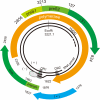Molecular epidemiology of hepatitis B virus
- PMID: 22016585
- PMCID: PMC3192197
- DOI: 10.3904/kjim.2011.26.3.255
Molecular epidemiology of hepatitis B virus
Abstract
Although safe and effective vaccines for hepatitis B virus (HBV) have been available for nearly three decades, this virus kills at least 600,000 people annually worldwide and remains the leading global cause of chronic hepatitis, cirrhosis, and hepatocellular carcinoma. Because the HBV reverse transcriptase lacks a proofreading function, many HBV genotypes, subgenotypes, mutants, and recombinants exist. At least 10 HBV genotypes (HBV-A through J) with distinct geographic distributions have been identified; by definition, their complete genomic sequences diverge by more than 8%. HBV genotype is increasingly becoming recognized as an important factor in the progression and clinical outcome of HBV-induced disease. Infections by HBV-C or -D are significantly more likely to lead to cirrhosis and hepatocellular carcinoma than are infections by HBV-A or -B. Additionally, the hepatitis B e antigen seroconversion response to standard or pegylated interferon is more favorable in patients with HBV-A or -B than in those with HBV-C or -D. However, therapeutic responses to nucleos(t)ide analogues are generally comparable among HBV genotypes. In conclusion, genotyping of HBV is useful in identifying chronic hepatitis B patients who are at increased risk of disease progression, thereby enabling physicians to optimize antiviral therapy for these patients.
Keywords: Antiviral agents; Genotype; Hepatitis B virus; Hepatocellular carcinoma; Molecular epidemiology.
Conflict of interest statement
No potential conflict of interest relevant to this article was reported.
Figures
Similar articles
-
Hepatitis B virus genotypes: global distribution and clinical importance.World J Gastroenterol. 2014 May 14;20(18):5427-34. doi: 10.3748/wjg.v20.i18.5427. World J Gastroenterol. 2014. PMID: 24833873 Free PMC article. Review.
-
Molecular identification of hepatitis B virus genotypes/subgenotypes: revised classification hurdles and updated resolutions.World J Gastroenterol. 2014 Jun 21;20(23):7152-68. doi: 10.3748/wjg.v20.i23.7152. World J Gastroenterol. 2014. PMID: 24966586 Free PMC article. Review.
-
The clinical implications of hepatitis B virus genotype: Recent advances.J Gastroenterol Hepatol. 2011 Jan;26 Suppl 1:123-30. doi: 10.1111/j.1440-1746.2010.06541.x. J Gastroenterol Hepatol. 2011. PMID: 21199523 Review.
-
Therapeutic implications of hepatitis B virus genotypes.Liver Int. 2005 Dec;25(6):1097-107. doi: 10.1111/j.1478-3231.2005.01177.x. Liver Int. 2005. PMID: 16343058 Review.
-
Hepatitis B virus genotypes: an overview.Hepatobiliary Pancreat Dis Int. 2008 Oct;7(5):457-64. Hepatobiliary Pancreat Dis Int. 2008. PMID: 18842489 Review.
Cited by
-
Epidemiology and molecular characterization of hepatitis B virus infection in isolated villages in the Western Brazilian Amazon.Am J Trop Med Hyg. 2012 Oct;87(4):768-74. doi: 10.4269/ajtmh.2012.12-0083. Epub 2012 Aug 20. Am J Trop Med Hyg. 2012. PMID: 22908032 Free PMC article.
-
Identification of hepatitis B virus A1762T/G1764A double mutant strain in patients in Southern Brazil.Braz J Infect Dis. 2017 Sep-Oct;21(5):525-529. doi: 10.1016/j.bjid.2017.05.002. Epub 2017 Jun 9. Braz J Infect Dis. 2017. PMID: 28606415 Free PMC article.
-
Prevalence and genotype distribution of viral hepatitis B in Cambodia between 1990 and 2020: a systematic review and meta-analysis.Arch Public Health. 2022 Apr 13;80(1):119. doi: 10.1186/s13690-022-00880-9. Arch Public Health. 2022. PMID: 35418163 Free PMC article. Review.
-
Seroepidemiology of Hepatitis Viruses and Hepatitis B Genotypes of Female Marriage Immigrants in Korea.Yonsei Med J. 2018 Nov;59(9):1072-1078. doi: 10.3349/ymj.2018.59.9.1072. Yonsei Med J. 2018. PMID: 30328322 Free PMC article.
-
Host Transcription Factors in Hepatitis B Virus RNA Synthesis.Viruses. 2020 Jan 30;12(2):160. doi: 10.3390/v12020160. Viruses. 2020. PMID: 32019103 Free PMC article. Review.
References
-
- Kao JH, Chen DS. Global control of hepatitis B virus infection. Lancet Infect Dis. 2002;2:395–403. - PubMed
-
- Kao JH, Chen PJ, Chen DS. Recent advances in the research of hepatitis B virus-related hepatocellular carcinoma: epidemiologic and molecular biological aspects. Adv Cancer Res. 2010;108:21–72. - PubMed
-
- Fattovich G, Bortolotti F, Donato F. Natural history of chronic hepatitis B: special emphasis on disease progression and prognostic factors. J Hepatol. 2008;48:335–352. - PubMed
-
- Lau JY, Wright TL. Molecular virology and pathogenesis of hepatitis B. Lancet. 1993;342:1335–1340. - PubMed
-
- Kao JH. Hepatitis B viral genotypes: clinical relevance and molecular characteristics. J Gastroenterol Hepatol. 2002;17:643–650. - PubMed
Publication types
MeSH terms
Substances
LinkOut - more resources
Full Text Sources
Medical

